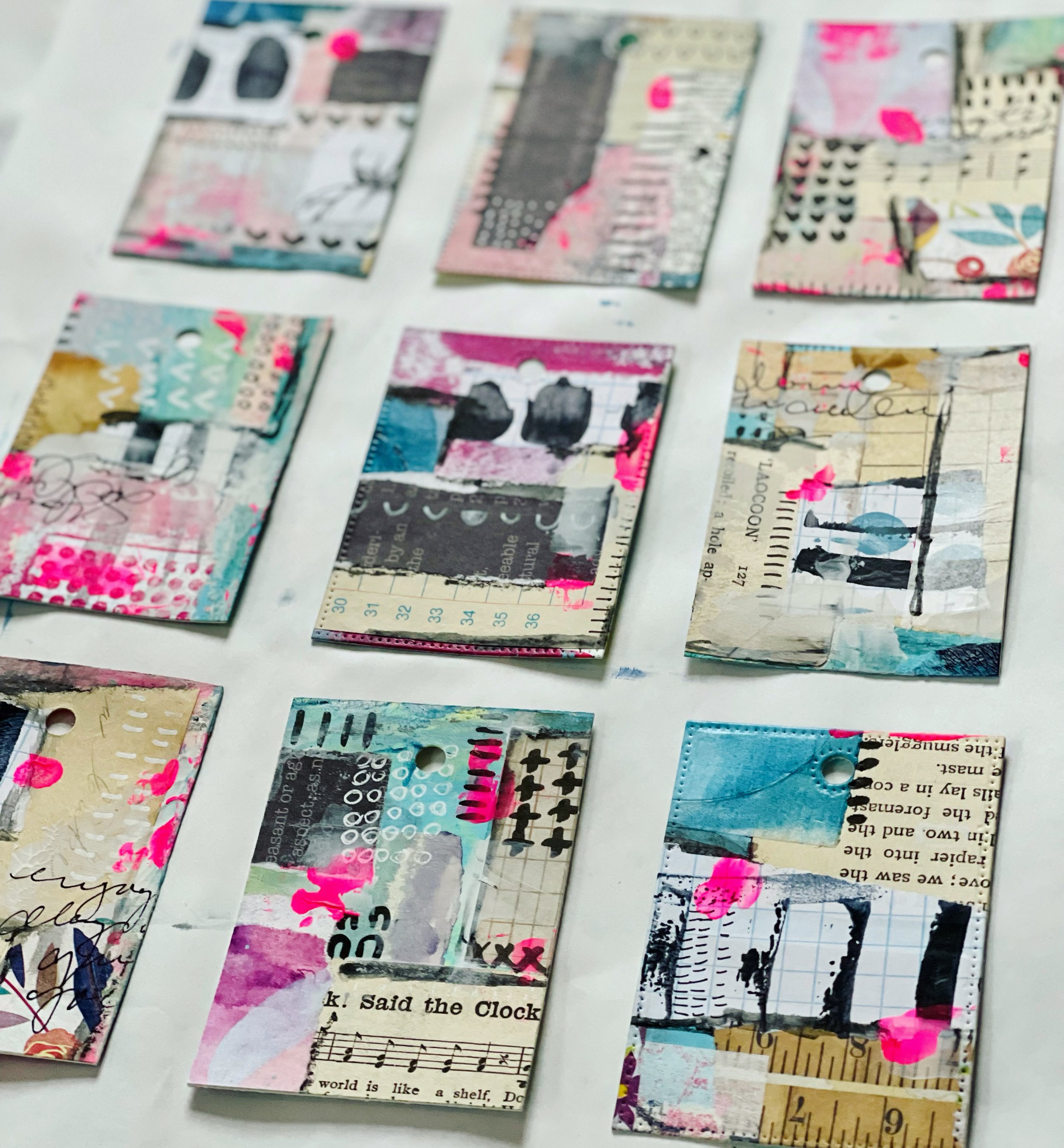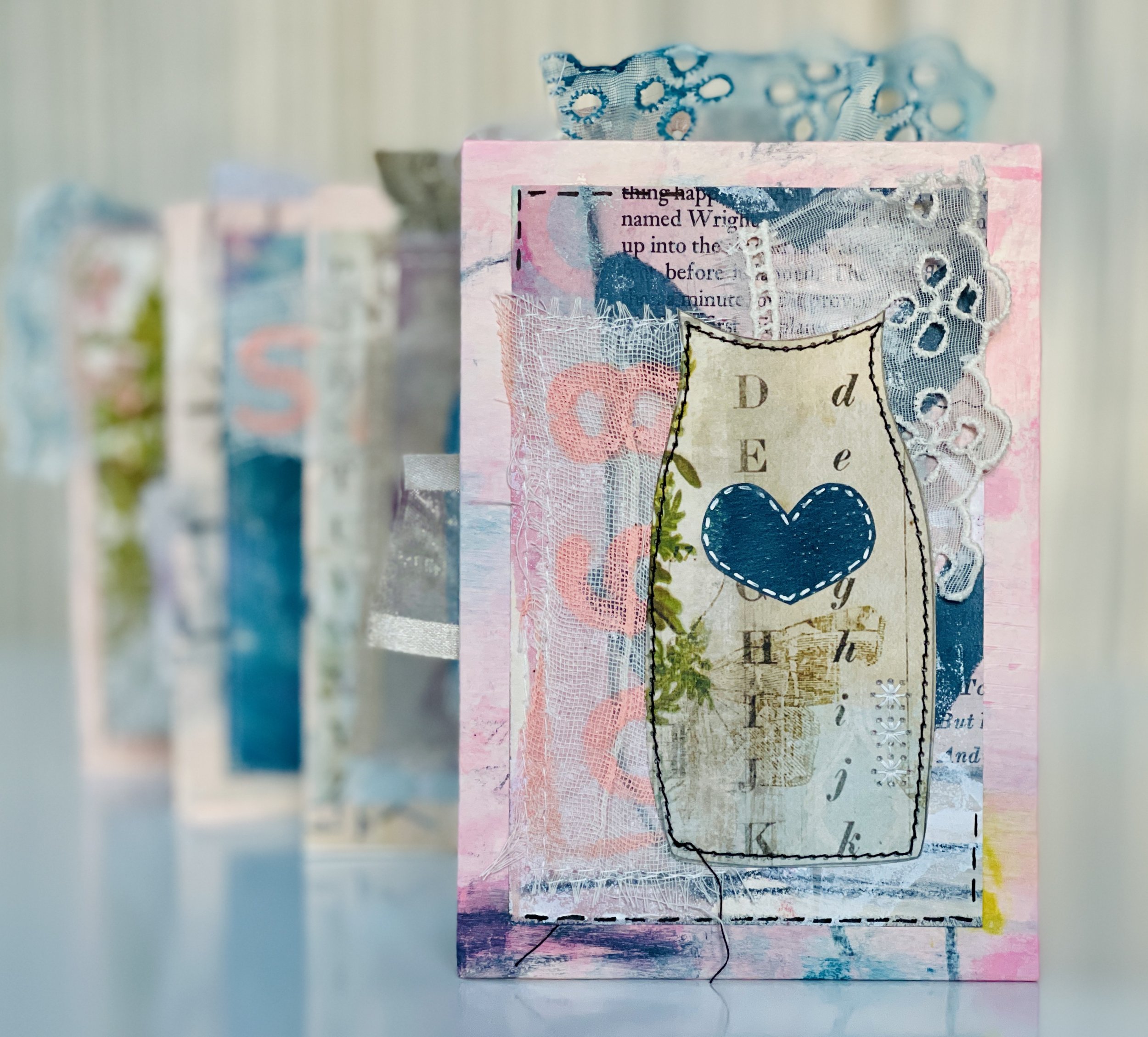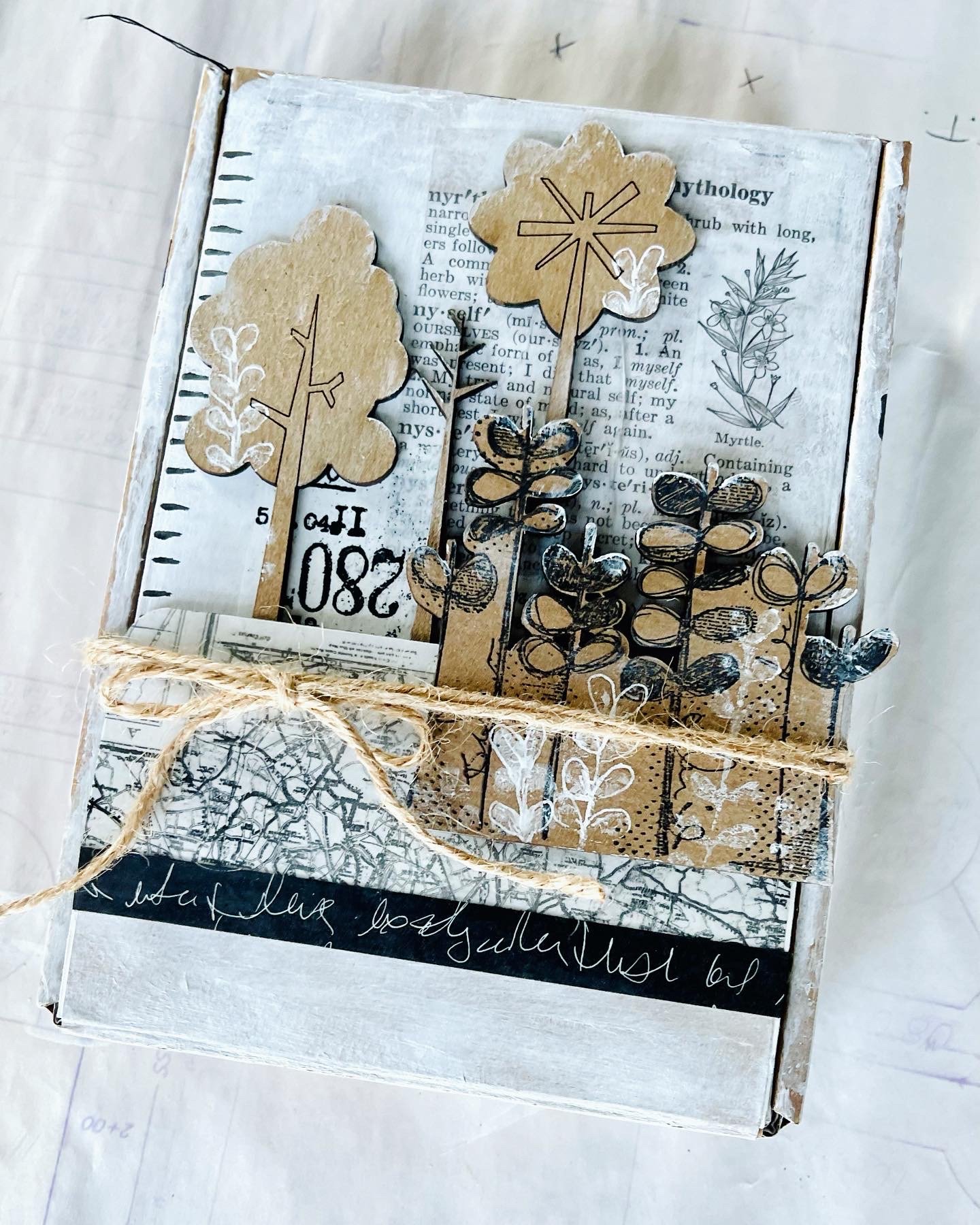Can I fit my own style into the art classes that I take?
This is the second article in a series on “Finding Your Style” on the Willa Wanders Blog. All artwork and images by Tiffany Sharpe @tiffanysimplysharpe.
Tiffany’s take on the prayer flag Fodder Challenge 2022 project from Dori Patrick.
Why finding my style is important to me
I guess saying that I have a style is kind of odd for me, because I feel like I’m still working on it, and that it will be something that will always evolve. I feel like the more I take classes and learn new techniques, the more opportunities I will have to truly narrow down exactly what my style is. This seems a little counter intuitive, because it might seem easier to explore this style on my own by creating my own projects. However, I love the added challenge of working my style into taking a course.
Tiffany’s take on the children’s board book Fodder School 2 project from Drew Steinbrecher.
I Thrive Off of Challenges
It has always been important for me to have my own style because I need the challenge of fitting my style into my artwork. It’s kind of like a puzzle for me, and when I don’t have that puzzle to solve, or challenge to overcome, my artwork tends to have less meaning and I don’t enjoy the process of creating as much.
There are two examples that I’d like to share, both are hobbies that I used to love and spent many years enjoying: knitting and quilting.
Knitting was something I could do to keep my hands busy, but I could easily put it down and tend to my kids and other household chores. When I knit, I would blindly follow the directions, not really knowing why the stitches were done a certain way, but knowing that somehow it would result in what the pattern maker had intended. Knitting was a hobby that I did to pass time and stay busy. I always ended up with beautiful results that I loved; however, I eventually grew bored and stopped knitting.
Tiffany’s take on the Fodder School 1 project from Megan Quinlan.
I had a different approach to quilting than with knitting, most likely because it was before I had kids and I could devote more of my time and energy to it.
When I was making quilts, I would often end up altering the pattern mid-way. I’d spend hours with my graph paper, redrawing the patterns and calculating all the measurements. That part was as much fun as constructing the quilt itself. I was adding my own style to these quilts, and I find myself going back to that hobby every few years, or infusing those techniques in my current art. Just a couple years ago, I even helped my son design and sew his first quilt.
Tiffany’s take on the Artist Trading Cards Fodder School 1 project from Sarah Gardner.
When I discovered mixed media art and art journaling, I began by working in the styles of other artists. I'd even go as far as using the exact same colors and materials as other artists. I found that, for me, this was a comfortable and relaxing way of creating without pressure. Eventually, I noticed that there was nothing cohesive about my projects, and I had a hard time using any leftover scraps from past projects in future ones. That’s when I began working in a limited color palette, and that one thing is what led me to find a style that I can call my own.
As I took more classes and learned more mixed media techniques, I started to choose my own colors and materials for my projects. As I grew more confident, I began to include small details of my own to projects. Somehow, during this natural process, I discovered my own style. I believe that discovering my style and challenging myself to fit my style into the classes that I take is why I love creating mixed media art so much.
Tiffany’s take on the wall art Fodder School 1 project from Laura Dame.
How I work in my own style
As someone who is relatively new to the world of mixed media, I find taking classes to be both rewarding and challenging. The rewarding part is more obvious, I end up with a beautiful creation and a toolbox full of new tips and techniques to use in future projects.
The challenge of taking classes can be that the end result can look too similar to the instructor’s work. When learning something completely new, or when a person hasn’t explored and found their own style, this is a great way to start. In fact, I believe that everyone begins here. We all learn by imitating what we see and like.
But there are ways that I add my own style and continue to discover my style while taking classes.
I’ve been able to add my own style in these situations by separating the techniques taught in a lesson from the general aesthetics of the lesson.
The easiest and most obvious way is by changing up the colors used. I have a limited color palette that I’ve been using for about a year. Although I change it up slightly at times by adding a new color or swapping out similar colors, I keep my main colors the same. I don’t always love those colors, and I’m still playing with how they all work together, but by only making a few, small changes at a time, I’m sticking with my own palette and fine tuning it at the same time.
Tiffany’s take on the accordion book Fodder School 1 project from Roxanne Padgett.
Another way I add my own style is by experimenting with using different materials.
Sometimes, I love using the exact same materials as the instructor. That's a great way to ensure that my project will work out and I will be able to have an easier time following each step.
However, using something different, especially something that I already have, makes the project my own. There can be complications and the need to problem solve when not using identical materials as the instructor, but I’m the type of person that loves a good challenge, and the end result can be unique and sometimes even more to my taste.
Sometimes, going “off script” can be helpful in adding my own style to a lesson. I’ve done this with many hobbies in the past. I remember following many quilting patterns, and then half way through, abandoning the pattern and creating my own. I loved the design aspect and once I was able to get started, I could understand how to take it in a different direction.
This is what I do with many mixed media art projects. I sometimes only watch half the lessons, and then get started. Once I start, many times, I end up being inspired (or distracted) by something else and will go in a new direction. This can end up with results that look very unique.
Tiffany’s take on the Fodder School 1 project from DeeDee Catron.
You may be in a place where you find comfort in following a class step by step. I imagine that most people take classes this way.
There is value in learning the exact way that the instructor intends, but if you’re looking for something more unique, I encourage you to experiment with the ideas here.
You might find that you are seeing your own style emerge in the artwork you create in the classes that you are taking. I think you’ll be surprised by how much more you will love the results.
Tiffany can be found on Instagram @tiffanysimplysharpe and on her website tiffanysimplysharpe.com.
Do you have specific ways that you try to infuse your own style into the art course projects that you create? We would love you hear your ideas in the comments below!









